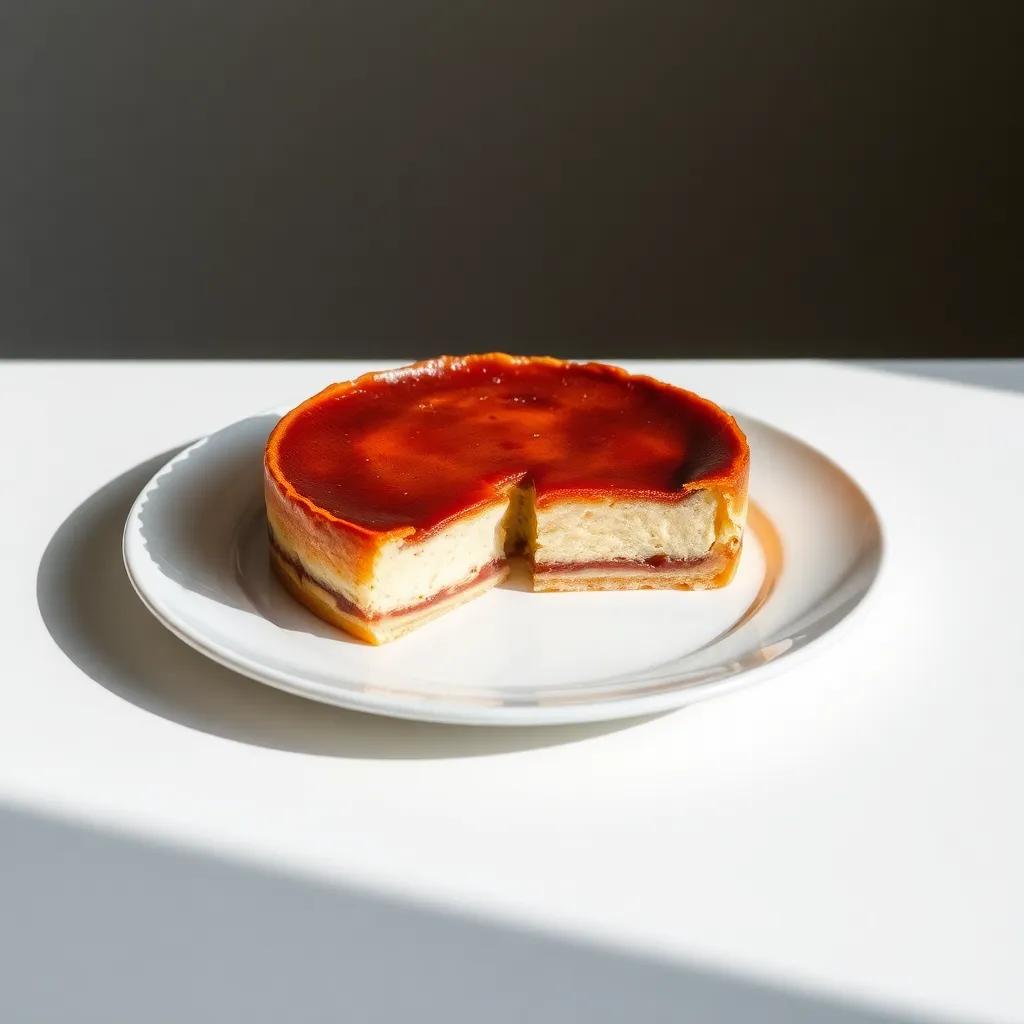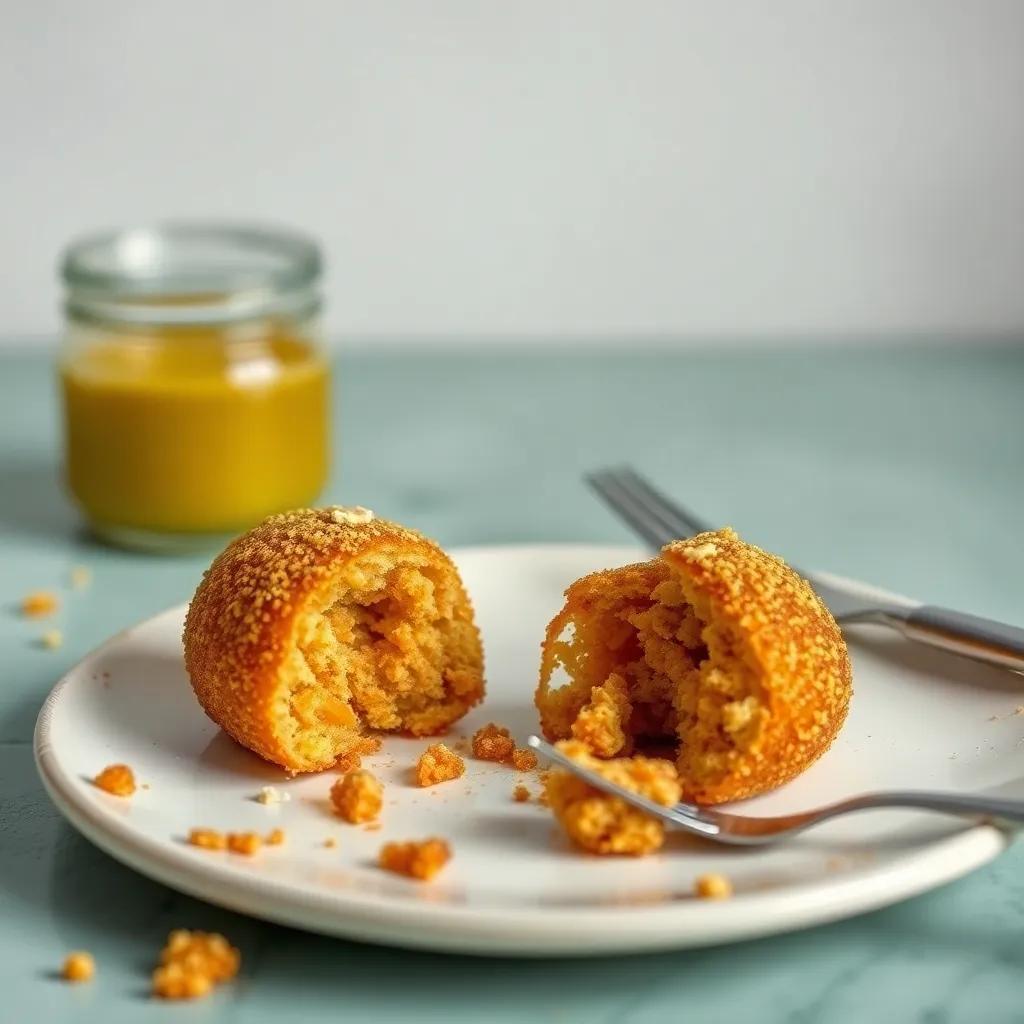Discover the Authentic Tarta de Santiago: Easy Spanish Almond Cake Recipe

Discover the Authentic Tarta de Santiago: Easy Spanish Almond Cake Recipe
🌍 Cuisine: Spanish
⚙️ Difficulty: Easy
Ingredients
Nutrition Facts
310 kcal
Instructions
- Preheat your oven to 350°F (175°C). Butter a 9-inch (23 cm) springform pan or cake tin and lightly dust with flour or line with parchment paper.
- In a large bowl, whisk the eggs and granulated sugar together until the mixture becomes pale, thick, and creamy (about 3–5 minutes).
- Add the ground almonds, lemon zest (if using), ground cinnamon, and flour (optional) to the egg mixture. Gently fold everything together until well combined but don’t overmix.
- Pour the batter into the prepared pan and smooth the top with a spatula.
- Bake in the preheated oven for approximately 30–35 minutes, or until the top is golden and a toothpick inserted into the center comes out clean.
- Remove the cake from the oven and let it cool completely in the pan on a wire rack.
- Once cooled, carefully remove the cake from the pan. Place the St. James Cross stencil on top (if available) and sift icing sugar over the entire surface.
- Remove the stencil gently to reveal the traditional cross design on the cake’s surface.
- Slice and serve the Tarta de Santiago at room temperature. It pairs beautifully with coffee or sweet dessert wine.
- Store leftovers at room temperature in an airtight container for up to 3 days, or refrigerate for longer freshness.
Serving Suggestions
- Serve with a dusting of extra powdered sugar for an elegant presentation.
- Pair with a cup of strong Spanish espresso or café con leche.
- Accompany with a glass of sweet sherry or a late-harvest white wine.
- Add a dollop of whipped cream or a scoop of vanilla ice cream for extra indulgence.
- Garnish with toasted almond flakes around the edge for extra crunch and visual appeal.
- Serve alongside fresh berries or fruit compote to add a tart contrast.
- Enjoy slightly warmed with a drizzle of honey or a splash of orange blossom water.
Table of Contents

Intro
There’s something quietly enchanting about the Tarta de Santiago—a classic Spanish almond cake that captures tradition, simplicity, and rich flavor all in one bite. Its tender crumb and subtly sweet almond character make it a dessert that feels both comforting and sophisticated, perfect for sharing with friends and family. Whether you’re celebrating a special occasion, looking to impress guests with an authentic taste of Spain, or simply craving a delightful treat alongside your afternoon coffee, this cake fits the bill beautifully.
What makes this recipe truly inviting is how approachable it is. Despite its storied heritage, you don’t need to be an expert baker or hunt down obscure ingredients to create a cake that tastes like it came straight from a rustic Spanish kitchen. With just a handful of pantry staples and straightforward steps, you can whip up a dessert that’s elegant but unpretentious—proof that great things often come from simplicity.
Enjoying Tarta de Santiago goes beyond the flavors; it’s about connecting with a piece of culinary history that has traveled centuries, carrying warmth and hospitality. So, whether you serve it sliced thin for a light finish after dinner or alongside a cup of rich espresso to brighten your afternoon, this almond cake invites you to slow down and savor the moment.
Ingredient Notes
When it comes to Tarta de Santiago, a few key ingredients play starring roles in creating its signature texture and flavor—understanding these can elevate your baking and help you achieve the authentic taste of this Spanish classic.
Ground Almonds (Almond Flour):
The heart and soul of Tarta de Santiago is undeniably the ground almonds, which give the cake its moist, tender crumb and distinctive nutty richness. Opt for finely ground blanched almonds, often labeled as almond flour, for the best texture. Coarser almond meal can work in a pinch but may result in a denser or grittier crumb. If you can find Spanish Marcona almonds—known for their sweeter, buttery flavor—they’re ideal for a truly authentic touch. However, regular blanched almonds ground fresh at home or store-bought almond flour will deliver excellent results.
Granulated Sugar:
Sugar in this recipe balances the almond’s natural earthiness and provides structure after whipping with eggs. While classic recipes call for white granulated sugar, you can experiment lightly with superfine sugar for smoother blending. Avoid substituting heavily refined or coarse sugars that don’t dissolve well, as that can impact both texture and sweetness distribution.
Fresh Eggs:
Eggs are essential not only for binding but also for aerating the batter when whipped with sugar. This contributes to the cake’s delicate lift and helps develop its elegant crumb. Using large, fresh eggs at room temperature ensures optimal volume. Eggs also enrich the flavor subtly, so freshness really makes a difference here.
Lemon Zest and Ground Cinnamon (Optional but Impactful):
Though not mandatory, a touch of lemon zest imparts a gentle brightness that cuts through the richness, creating a layered flavor profile. Ground cinnamon adds warmth and aromatic depth, echoing traditional Andalusian spice notes. When using these, peel just the yellow part of the lemon (avoiding white pith) to prevent bitterness, and use cinnamon sparingly—too much can overpower the delicate almond essence.
Butter (For Greasing):
While butter doesn’t make its way into the batter, it’s critical for greasing your pan to achieve a clean, crack-free release. Butter imparts a subtle flavor and helps the cake’s edges brown evenly. If you prefer, lightly oiling the pan with a neutral oil works as a substitute, but butter is preferred for its rich aroma.
Knowing these ingredient nuances lets you adapt while keeping the cake’s true character intact. Whether you’re sourcing specialty almonds or choosing to highlight the subtle citrus and spice notes, these choices make the difference between an everyday almond cake and a genuine slice of Spanish heritage.
Tips & Variations
To get the most from your Tarta de Santiago experience, a few smart tips and tweaks can make all the difference—whether you’re aiming for flawless texture, experimenting with flavors, or accommodating dietary needs.
- Whip the Eggs Properly: The key to that tender, light crumb lies in thoroughly whisking the eggs and sugar together until pale and creamy. Don’t rush this step; a full 3 to 5 minutes with a hand or stand mixer will incorporate enough air to give the cake its signature softness and delicate rise.
- Almond Texture Matters: While finely ground almond flour is ideal, if you only have coarser almond meal, try pulsing it briefly in the food processor before mixing. This quick step can smooth out the graininess without sacrificing the almond’s nutty flavor.
- Flour—Use it Sparingly or Skip It: The optional tablespoon of all-purpose flour helps stabilize the cake’s structure, but if you want a gluten-free version, simply omit it. The cake will be a bit more delicate but still delicious—just handle gently when slicing.
- Add Your Own Twist on Aromatics: Lemon zest and cinnamon are classic, but feel free to experiment subtly. A splash of orange zest or a pinch of nutmeg can bring new aromatic layers that complement the almonds beautifully without overpowering them.
- Go Nuts with Nut Toppings: For added texture and flair, sprinkle some sliced or slivered almonds on top before baking. They’ll toast and create a lovely golden crust, adding crunchy contrast to the moist interior.
- Vegan Variations: While eggs are fundamental here, you can try replacing each egg with flaxseed “eggs” (1 tablespoon ground flaxseed mixed with 3 tablespoons water, chilled until gelatinous). Expect a denser cake and a slightly different flavor, but it’s a great approach for vegan diets, especially when combined with almond flour’s natural richness.
- Sweetener Substitutions: If you prefer less refined sugar, try using coconut sugar for a deeper caramel note, or raw honey for natural sweetness—though keep in mind these may slightly alter the texture and browning of the cake.
- Pan Choices: Although a 9-inch springform pan is recommended for an easy release, you can also bake this in a regular cake tin lined with parchment paper or even individual tart pans for charming single servings.
- Make It Mini or Layered: For a fun presentation, try dividing the batter into mini tart tins or muffins for bite-sized treats. Alternatively, bake in a shallow dish and layer with whipped cream or fruit compote between slices to create an elegant, layered dessert.
By keeping these tips and variations in mind, you can adapt the Tarta de Santiago to suit your taste, dietary preferences, and even presentation style—while preserving the essence of this beloved Spanish classic.
Leftovers & Storage
After the joy of savoring your freshly baked Tarta de Santiago, you might find yourself with some delicious leftovers worth preserving properly. This almond cake holds up wonderfully when stored with a bit of care, allowing you to enjoy its tender crumb and nutty flavor a few days down the line.
For short-term storage, keeping the cake at room temperature is perfectly fine as long as it’s tucked into an airtight container or wrapped tightly in plastic wrap. Stored this way, the cake stays moist and fresh for up to 3 days. This is ideal if you plan to enjoy it as a midday treat or dessert within a couple of days after baking. Make sure the container is sealed well to prevent the cake from drying out or absorbing any odors from your kitchen.
If you’re looking to extend its shelf life, refrigerating your Tarta de Santiago is best. Wrap the cake or individual slices tightly in plastic wrap or place them in an airtight container to lock in moisture and prevent the cake from becoming crumbly or dry. When refrigerated, the cake will keep well for up to 5–7 days. To enjoy it at its best, allow refrigerated slices to come back to room temperature before serving, which helps revive the almond aroma and soft texture.
For longer storage or if you want to prep ahead, freezing is your friend. Wrap the cake tightly in plastic wrap and then cover it with aluminum foil or place it inside a freezer-safe container or ziplock bag to protect against freezer burn. Frozen Tarta de Santiago can last up to 2 months without significant loss of flavor or texture. When ready to enjoy, thaw the cake overnight in the refrigerator, then bring it to room temperature before serving. Avoid microwaving, as it can affect the delicate crumb.
If you’ve cut the cake into slices, you can freeze them individually to grab a single portion when the craving strikes. Simply wrap each slice tightly and freeze as described. This approach works especially well if you want a ready-made dessert for unexpected guests or a quick coffee break indulgence.
Meal prepping with this cake is quite straightforward because it maintains its flavor wonderfully even after a day or two. Consider slicing the cake and portioning it out in airtight containers for easy grab-and-go servings—perfect for picnics, lunchboxes, or sharing at gatherings without fuss.
In summary, whether you store it on the counter for a couple of days, chill it to keep it fresh longer, or freeze it for future enjoyment, your Tarta de Santiago will reward you with its signature richness and tender crumb as long as it’s kept lovingly wrapped and protected from air. This little effort ensures you can relish every slice of this classic Spanish almond cake at your own pace.
Behind the Recipe
Tarta de Santiago is much more than just an almond cake—it’s a tangible piece of Spanish history woven into the culinary traditions of Galicia, the northwestern region of Spain. Believed to have originated centuries ago as a humble pilgrim’s cake, it was made with simple, readily available ingredients like almonds, eggs, and sugar—ingredients that travelers along the famed Camino de Santiago could carry easily on their journey to the shrine of Saint James in Santiago de Compostela.
The iconic St. James Cross dusted atop the cake is not just decorative; it symbolizes the deep spiritual and cultural significance tied to the pilgrimage. Bakers would traditionally mark this symbol to honor the saint and signify the cake’s authenticity. Over time, the Tarta de Santiago became a beloved dessert beyond the pilgrimage routes—celebrated during festivals, family gatherings, and as a comforting everyday treat. Its simplicity and nutty elegance capture the essence of Galician hospitality: generous but unpretentious.
On a personal note, many home bakers cherish making this cake as a way to connect with Spanish roots or to bring a taste of Iberian heritage to their own tables. Because it requires no elaborate techniques or intimidating ingredients, it offers a delightful sense of accomplishment and a way to honor centuries-old customs with every delicious slice. Whether you view it as a keepsake of cultural storytelling or simply enjoy its tender crumb and sunny almond flavors, the Tarta de Santiago invites you to partake in a centuries-old tradition of warmth, sharing, and celebration.
FAQ
Can I use almond flour instead of ground almonds for this cake?
Is there a gluten-free version of this recipe?
How should I store leftover Tarta de Santiago?
Can I freeze Tarta de Santiago, and how do I reheat it?
What can I use instead of eggs if I want a vegan version?
How do I get the classic cross of Saint James design on top?
Can I add additional flavors or toppings to this almond cake?
Try It Yourself
There’s something truly special about the classic Tarta de Santiago — a simple, tender almond cake that carries the rich flavors and traditions of Spain in every bite. This easy recipe brings that authentic charm right into your kitchen, inviting you to savor a slice of history with minimal fuss but maximum delight.
If you give it a try, we’d love to hear how it turns out! Feel free to leave a comment, share your rating, or even tell us about your own personal twist on this timeless treat. Happy baking, and ¡buen provecho!












